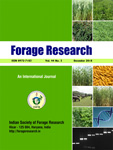RENU DEVI, SHWETA, SATPAL, ANU*, ANIL KUMAR, RAJESH KUMAR, POOJA, KRISHNA AND POOJA DALAL
Department of Agronomy,
CCS Haryana Agricultural University, Hisar-125 004 (Haryana), India
*(e-mail: anusheoran151@gmail.com)
(Received: 1 April 2025; Accepted: 31 May 2025)
SUMMARY
A field study entitled “Effect of variety, planting time, and spacing management on growth parameters of fodder Moringa,” was carried out at Agronomy Research Farm of CCSHAU, Hisar, Haryana, India using the crop that was sown in the summer season of 2023. Sandy loam soil with a somewhat alkaline composition, 0.43% organic carbon, low available nitrogen, medium available phosphorus, and medium available potash was found at the experimental site. In factorial RBD with three replications, two varieties viz. PKM-1 and Moringa desi were assessed on two sowing dates (10 March and 25 March) and three spacings (30 cm × 15 cm, 30 cm × 30 cm, and 45 cm × 15 cm). According to the results, the PKM-1 variety performed noticeably better than Moringa Desi in terms of growth characteristics. Better growth, nutrient uptake, and financial gains were obtained from sowing on March 10th as compared to March 25th sowing. Wider spacing improved the performance of individual plants, whereas, 30 cm × 15 cm spacing produced the highest gross and net returns. The results reveal that the PKM-1 variety, which was displayed on March 10 at a spacing of 30 cm × 15 cm, has the potential to maximize yield and financial returns in Moringa farming.
Key words: Moringa, variety, sowing time, spacing, management, growth, productivity, quality, profitability and fodder

